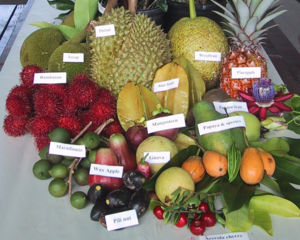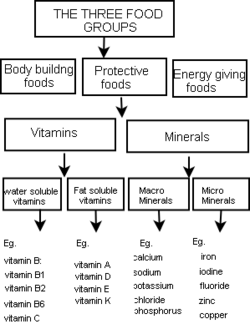Lesson 4: Protective Foods
Contents
PROTECTIVE FOODS
Introduction
| When some one mentions the word ‘protective’ what comes to your mind immediately? The police or the army? Or your father or mother or elder brother or sister? You will not be far from right at all because these people are sometimes like a cover over us so that no harm would come to us. They would fight anyone who dares come near to harm us. |
Lesson content
Similarly protective nutrients are those nutrients which help to protect our body from harm.
In this unit we would be looking at those nutrients we get from food which help the body to produce substance which prevent us from bodily harm.
After studying this unit you would be able to:
|
| Protective nutrients include vitamins and minerals. Water can also be classified as protective because of its many regulatory functions. |
Vitamins
{Definition|TopMargin=10px|Vitamins are substances which are needed in small amounts in the body for cellular metabolism.}} They are divided into two broad groups based on whether they dissolve in water or fat. Vitamins which dissolve in water are called water-soluble vitamins and those that dissolve in fat are called fat soluble vitamins.
Table 1:TYPES OF VITAMINS
| Water soluble vitmins | Fat soluble vitamins |
| vitamin A | vitamin C is also called ascorbic acid |
| vitamin D | vitamin B complex, a number of B vitamin including; |
| vitamin E | vitamin B1 Thiamin |
| vitamin K | vitamin B2 Riboflavin |
| vitamin B3 Niacin | |
| vitamin B6 |
Vitamins are released from food during digestion and most of the water soluble vitamins are absorbed directly across the intestine wall.
Excess water soluble vitamins are excreted with the urine. Excess fat soluble vitamins are stored in the body. Some vitamins can be made by the body.
Functions of vitamins
- Energy metabolism – they help the body to release energy from the energy nutrients
- Red blood cell synthesis
- Anti-oxidation
Sources
Most water soluble vitamins are found in animal foods, fruits and vegetables, cereals and legumes.
Fat soluble vitamins are found in fatty foods.
Cooking implications for vitamins
The fat soluble vitamins remain relatively stable to heat and meal preparation methods. however water soluble vitamins are easily destroyed by most cooking methods.
Vitamin C is a very important water soluble vitamin because it helps to keep the body healthy in many ways. It however not stored so people need to eat foods rich in vitamin C daily.It is water soluble so excess amounts are eliminated daily in the urine. It is easily destroyed by heat. It leaches into cooking water. It is volatile and therefore evaporates easily. It is destroyed by metals like copper and it is easily oxidizes. Therefore in cooking vegetables or fruits which are good sources of vitamin C the above information should be considered. Cut fruits and vegetables should not be exposed unnecessarily or left in water. They should be cooked for short periods in well covered pans. Water in which fruits and vegetables are cooked should be used as stock. Very high temperatures should not be used in cooking fruits and vegetables.
Minerals
Another group of protective nutrients is minerals. They are divided into two groups. The macro minerals and the micro minerals or trace minerals.
| Macro minerals are those minerals found in large amounts in the body. They include calcium, sodium, potassium, chloride and phosphorus.
Trace minerals include iron, iodine fluoride, zinc and copper. Minerals are not digested in the body. They simply need to be released from food. |
The minerals in our bodies are in the form of ions which can carry electrical charges. Minerals therefore help in the maintenance of fluid balance, transmission of fluid balance, transmission of nerve impulses and contraction of muscle.
Mineral absorption into the body depends on many factors one of which is the presence of certain chemicals in the food. These chemicals form insoluble salts with the minerals and therefore they are not absorbed. The way food is prepared can have effect on how much of these minerals are absorbed.
Fermentation of food for example will break up the molecule of some of these chemicals. Addition of line juice to cereal products also prevents the chemicals. Addition of line juice to cereal products also prevents the chemicals from combining with the minerals. Minerals are usually found in vegetables, cereals and animal products.
Summary
Vitamins and minerals are important because they help to keep the body healthy by regulating body processes and helping the body to produce substances that fight disease causing agents.
They are mostly found in fruits and vegetables, cereals and animal foods.
Vitamins help in energy metabolism when foods are not properly cooked the water soluble vitamins are lost vegetables should be handled well during meal preparation to avoid loss of vitamins.
Conclusion
Well done, you have successfully completed this lesson, hope to continue some other time.
| Read on the six food groups |
For more information click here Vmensah 17:25, 26 February 2007 (CET)


